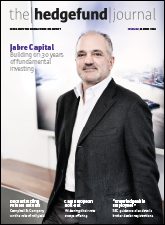 Nearly five years post-crisis, cash manager Sentinel’s ex-CEO, Eric Bloom, has just been found guilty on 19 counts of fraud and faces up to 20 years in a federal jail. Many in our industry argue that such counterparty failures and frauds are avoidable through robust due diligence, but these crisis mishaps fostered political pressures behind the AIFMD requirements for strict depositary liability. Although boards of AIFs can agree to discharge part of this liability, the degree of liability is a higher standard than currently applies under UCITS. But not for long – as recently firmed up UCITS V details will soon align depositary liability for UCITS with the AIFMD regime, as well as rendering UCITS remuneration rules close to those under AIFMD.
Nearly five years post-crisis, cash manager Sentinel’s ex-CEO, Eric Bloom, has just been found guilty on 19 counts of fraud and faces up to 20 years in a federal jail. Many in our industry argue that such counterparty failures and frauds are avoidable through robust due diligence, but these crisis mishaps fostered political pressures behind the AIFMD requirements for strict depositary liability. Although boards of AIFs can agree to discharge part of this liability, the degree of liability is a higher standard than currently applies under UCITS. But not for long – as recently firmed up UCITS V details will soon align depositary liability for UCITS with the AIFMD regime, as well as rendering UCITS remuneration rules close to those under AIFMD.
On top of safety nets and deferred carrots, UCITS V has sticks. It ushers in US-style fines, of up to €5 million for individuals and 10% of turnover for companies. The turnover-related figure is extraordinary – it matches levels of fines applying to cartels that breach EU anti-trust competition laws, so penalties could run into hundreds of millions. Harmonising the sanctions regime throughout the EU is designed to remove the incentive for regulatory arbitrage, at least within Europe. Managers who cannot countenance this level of regulation may seek solace in Caribbean islands, although the British Virgin Islands is also raising its regulatory game, according to one of our service provider awards winners, Maples & Calder, writing in this issue.
The nitty gritty of regulation increasingly looks like more of an art than a science. As part of its “single rulebook” mission, independent Paris-based agency ESMA is empowered to draft technical standards – as is Frankfurt-based EIOPA – but in both cases the interpretation of rules seems an iterative and evolutionary process. Hence the extensive consultation processes, recently over collateral diversification rules for UCITS and ETFs, and the constant revision of Q&As on regulators’ websites.
One case study on new technical standards is ESMA’s changes to the criteria for investable financial indices back in mid-2012. This provoked myriad responses. Some funds doing total return swaps with indices simply shut down. Others replaced indices with certificates. Other managers tell us that engaging in constructive dialogue with ESMA has, for instance, allowed them to continue operating index-related funds, without revealing their “secret sauce”. Meanwhile other proprietary index strategies are simply re-branded as active UCITS. This illustrates creative and fluid thinking on both sides of the regulatory fence.
Investors seem unperturbed by the growth in regulation as February witnessed the largest inflows into hedge funds since 2008, says AIMA. The Prequin survey in this issue helps to map out where the capital is coming from. The USA clearly offers a fatter cake where hedge fund managers can also bite off larger slices of institutional portfolios. But we think European hedge fund managers should look east as well as west, particularly as Asians are abundant savers. Reciprocal recognition between Hong Kong and China funds will soon be a reality. Not to be outdone, Luxembourg – already a leading renminbi centre – is assiduously working towards mutual recognition between Luxembourg and Chinese funds.
- Explore Categories
- Commentary
- Event
- Manager Writes
- Opinion
- Profile
- Research
- Sponsored Statement
- Technical
Commentary
Issue 93
Editor’s Letter – March 2014
Issue 93
HAMLIN LOVELL, CONTRIBUTING EDITOR
Originally published in the March 2014 issue